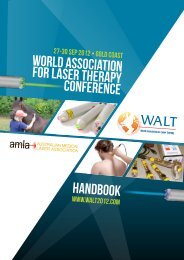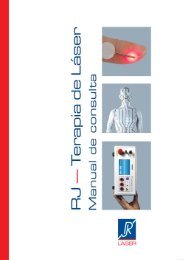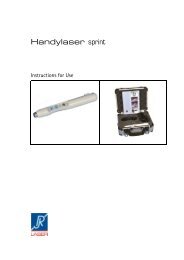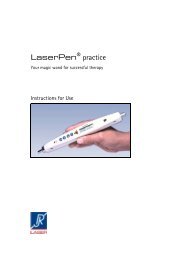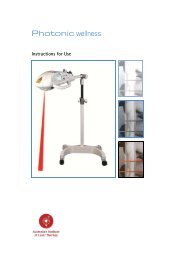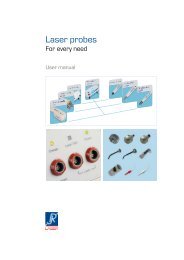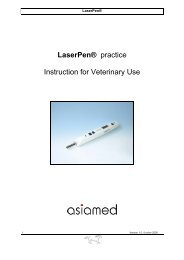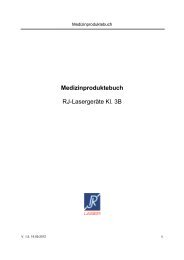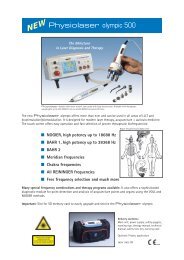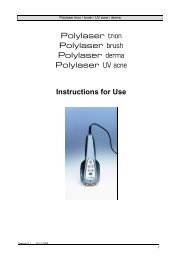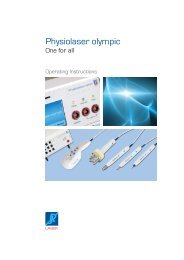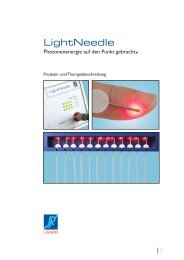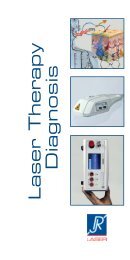LightNeedle - RJ Laser
LightNeedle - RJ Laser
LightNeedle - RJ Laser
Create successful ePaper yourself
Turn your PDF publications into a flip-book with our unique Google optimized e-Paper software.
<strong>Laser</strong>needle@ acupuncture at the acupoint Yintang<br />
was performed using a new method for optical stimulation.<br />
This method was reported by our research<br />
group in the scientific literature in 2002 [6,7]. The<br />
<strong>Laser</strong>needle@ technique represents a new, noninvasive<br />
method for optical stimulation of acupuncture<br />
points. The laser used in this study emits red light<br />
in continuous-wave mode with an output power of<br />
30-40 rn W, which results in a radiant exposure energy<br />
of about 2.3 kJ cm-2 at the acupuncture point during<br />
a stimulation time of 10 min [6].<br />
Acupressure on the control point (location: 2 cm<br />
from lateral end of the left eyebrow; Fig. Id) was<br />
performed in similar manner as on the acupoint<br />
Yintang (duration 10 min).<br />
All subjects had four conditions applied (Fig. la-d).<br />
The persons were in a semi-lying position with<br />
closed eyes. The choice of the stimulation procedure<br />
was randomized within a subject and the interval<br />
between the different sessions was at least 20 min.<br />
Evaluation parameters<br />
The main evaluation parameters were BIS and SEF90<br />
during the different conditions (Fig. 1) and time<br />
intervals (Fig. 2). Measurements were made at time<br />
points a-g (Fig. 2). In any one condition we recorded<br />
BIS and SEF values continuously but sampled the<br />
data for subsequent analysis at seven points. A single<br />
reading was taken at each point. The stimulation<br />
was not stopped at the time of reading. The whole<br />
study session lasted 2-3 h. BIS and SEF90 represent<br />
single numbers, which should decrease continuously<br />
with decreasing level of consciousness (hypnosis).<br />
There are several review articles for methodological<br />
details of signal processing of BIS and SEF [3].<br />
After 5 min of stimulation (Fig. 2d) the subjects<br />
were asked to move their right hand to clarify that<br />
they were awake and not asleep. In addition, before<br />
and after each stimulation mode the persons were<br />
asked to score their stress and tension based on a VSS<br />
from 0 (no stress) to 10 (maximum stress) [4]. Heart<br />
rate (HR) and noninvasive blood pressure (BP) were<br />
also recorded before and after acupressure stimulation<br />
Figure 2.<br />
Stimulation procedure and different measuring points before<br />
(a) during (b-f) and after (g) stimulation.<br />
Nonpharmacological influences on BIS and SEF 15<br />
at Yintang (measurement points:<br />
and 1 min after 'g' (cf Fig. 2».<br />
Statistical analysis<br />
min before<br />
The BIS and SEF data were tested with analysis of<br />
variance (one-way repeated measures ANOVA;<br />
similar data were found to be normally distributed<br />
in previous investigations) using SigmaStat@ Oandel<br />
Scientific Corp., Erkrath, Germany). Dunnett's<br />
method was used for post hoc analysis; VSS data were<br />
compared using paired t-test. The results were<br />
graphically presented as box plots (BIS and SEF) and<br />
as scatter plot (VSS). Changes were considered<br />
significant at p < 0.05.<br />
Results<br />
All subjects completed the study. Figure 3 shows the<br />
decreases of BIS values during acupressure applied to<br />
the acupoint Yintang in all 25 healthy volunteers.<br />
1 : r- ST'J ~<br />
60[<br />
4Oi<br />
100~S 5<br />
i -<br />
80' T\J<br />
6oi \Ji<br />
40~<br />
100~S --<br />
:r fJ:iijJ<br />
4of<br />
9<br />
100~S<br />
r .-<br />
13<br />
8° 1<br />
60,<br />
:rrrrrr<br />
I U r<br />
401<br />
100r.ߧ<br />
801 r<br />
60[<br />
40,<br />
~<br />
1COrJ?!J§- 21<br />
:~\ ~<br />
40[<br />
100;=-~J§ 25<br />
:~I ~<br />
4oi<br />
2<br />
rw<br />
6<br />
f"'ir<br />
17 18<br />
~<br />
~<br />
3<br />
7<br />
~<br />
4<br />
"'W<br />
14 15 16<br />
vii:"<br />
~<br />
~<br />
~<br />
'V<br />
,-,<br />
22<br />
10 min<br />
~<br />
19 20<br />
-<br />
23<br />
:r--r<br />
f\;Mr<br />
"*\\I<br />
Y intang n= 25<br />
Figure 3.<br />
The trend of BIS values of 25 healthy volunteers { 1-25) before,<br />
during and after acupressure performed on the acupoint Yintang.<br />
All subjects were awake. Note the significant decrease {minimum<br />
BIS = 35; no.14) due to acupressure.<br />
24



